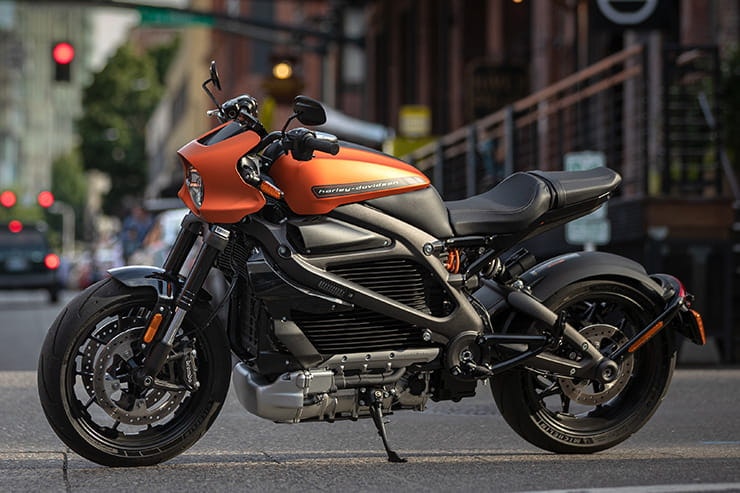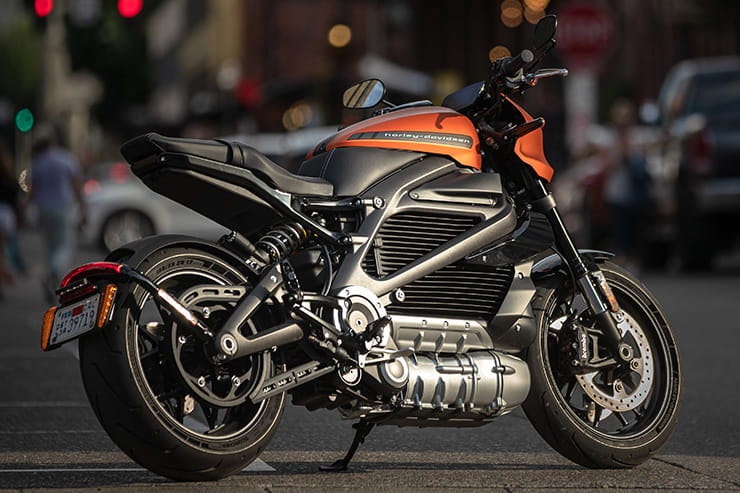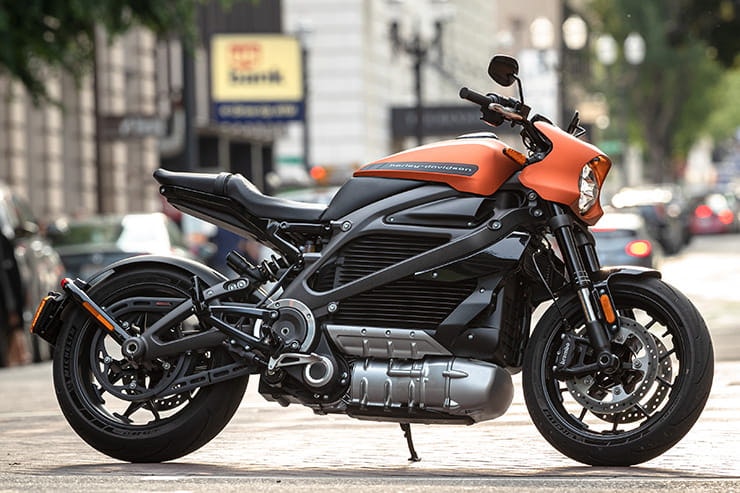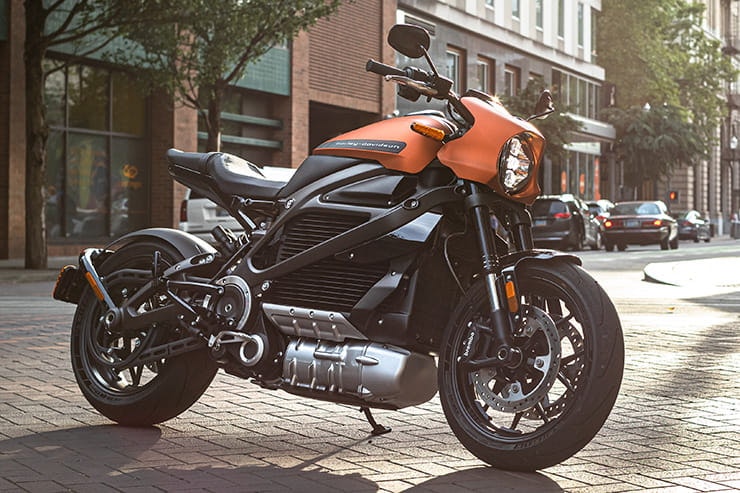KIT CREDITS
Thus far, in electric motorcycle history, pretty much every serious, every-day electric bike out there comes from a niche manufacturer: Zero and Energica are the obvious examples that come to mind. The arrival of Harley-Davidson's LiveWire, however, marks the first mega-brand to launch an all-electric motorcycle against the backdrop of a huge dealer and support network. It's a total no-brainer to think that almost every other mainstream manufacturer out there must be furiously working away at their own electric plans, but what's utterly crazy is that Harley-Davidson, given all the things it stands for, is the first of the big ones to push an EV out of the factory doors.
You have to stand back and wonder what a mainstream manufacturer's product ends up being like when it’s compared to a niche manufacturer. Electric motors seem to be a bit of a leveller – they don't have much personality and they all sound roughly the same, which is in stark contrast to internal combustion engines (ICE). It's not uncommon to set out to buy an ICE motorcycle having decided on the engine configuration and nothing else. To whit, Harley-Davidson just as much as Ducati are known for V (and L) twins, Triumph is known for triples, and an entire narrative surrounds Royal Enfield's recent move into (gasp!) twin-cylinder engines.
Harley's solution to this, it appears, is to try and inject a bit of internal-combustion-engine-like behaviour into its electric motors, with the aim of re-creating a bit of character and theatre. That would seem like a good idea; after all, we do tend to bond with our bikes’ personalities. The question is, has it worked?
2019 Harley-Davidson Livewire electric bike price
There's no point beating around the bush. A Harley-Davidson Livewire is going to cost you £28,995 plus on-the-road costs. That’s a fair chunk of anyone’s money, and to put that into perspective, it's a full £10,505 more than Zero's new SR/F, and roughly £9,000 more than Energica's Esse Esse 9. £28,995 is enough to buy Ducati Panigale V4 S and a Honda Monkey 125, with a thousand quid in change left over to blow on a 65" 4k Smart TV. Or you could bag about 3 bitcoins, depending on what you're into. Anyway you get the idea: it's really expensive.
Of course, it was always going to be wallet unfriendly. The intended audience is presumed to have money and be happy to pay a premium, and, as a sector, EVs are still very much in the early-adopter phase (especially in motorcycling). Although arguably the rate at which that's eroding is only going to accelerate as time goes on.
Harley-Davidson no doubt has an aggressive plan to claw back its investment in EV, and will be ploughing that cash back into new models and continuing R&D. The Livewire is just the first in a long series. And all that money is also going towards equipping the dealer network with all the knowledge and tooling to deal with these electric bikes. 12 UK and 250 worldwide dealers will be capable to start with. No longer will it be a case of just two dealerships nationwide – if you're lucky – to service your EV; how about almost every H-D dealer out there?
You'll be able to make use of the UK Government's EV grant, which will score you a 20% discount up to a maximum of £1,500, so you can reduce that gut-punching price tag to £27,395, which is something, at least. That £1,500 saved will bag you around 10,000 kW/h, which is roughly 500 full charges, which might work out at around 5,000 miles of ‘free’ mileage. Better than a kick in the teeth or a wasp in your jacket.
There is, as always, a catalogue of parts you can start to chuck at the Livewire, but compared to the usual doorstep-proportioned Harley-Davidson parts catalogue, it's a bit of a rag – just carbon fibre bits and pieces for now. More is coming, says Harley-Davidson.
Power and torque
105hp is the magic number at 15,000rpm, and there's 85.6lb-ft (116Nm) of torque available right from zero revs, as you'd expect with an electric motor. The torque is delivered like any other electric bike – in one continuous, unrelenting and completely linear fashion. Twist the throttle and it'll surge forwards rapidly in a way that in no way hints at how fast you end up travelling; looking down at the speedo can be a surprising experience after you've bitten the dashboard and stretched the imaginary throttle cables.
There are four pre-programmed throttle modes: Sport, Road, Rain and Range, which are set to deliver different levels of power, regenerative braking and traction control.
Harley-Davidson claims 0-60 in three seconds and 60-80 in two seconds. And those claims are more or less verified by BikeSocial's backside dyno; it absolutely romps away from the lights. As there's no clutch or gears to worry about, you'll win literally every game of traffic light GP you care to enter. Of course it's useful at other times too – darting into gaps in traffic or annihilating whatever it is you're overtaking out on the open road. After about 90mph the acceleration tails off a bit, but it still quite quickly finds its way to 115mph and stops at about there.
It's entertaining stuff, even if there's no real theatre to it, only a whirry noise from the drivetrain. The throttle's beautifully predictable and mega smooth, and really easy to get on with.
Alongside the hardcoded power/throttle modes, there are two more customisable modes (Custom A, Custom B) where throttle response, regenerative braking and power can be set independently at 1% increments, and traction control set as low, medium or high. TC can also be fully disabled in any mode, and there's more than enough shove to lift the front wheel if you want to.
Engine, gearbox and exhaust
The Livewire doesn't have an engine, gearbox or exhaust, but it has equivalents, kind of.
The motor's built by an external company in Italy, but Harley-Davidson was heavily involved in its design and development, and employs full-time electrical motor engineers at its headquarters in Milwaukee. The motor itself – like Harley's V-twin engines – is seen as a feature of the bike, and for that reason it's proudly and deliberately bolted to the bottom of the battery casing for the world to see – it should be obvious, but if not, it's that silver cylindrical thing.
At a stand-still, the motor pulses in a heartbeat fashion. Lub-dub. It does this by sending just a twitch of power to the motor, which kicks it, but nowhere near enough to actually move the bike. I actually really liked this; you can feel it through the seat, pegs and bars, and it keeps you focussed when waiting at traffic lights. It definitely seems to give you the feeling that the bike's alive, rather than dead when you're not touching the throttle.
As far as we're aware, the Livewire is the first electric bike to make a proper visual feature of the motor. Other manufacturers tuck the motor up behind the battery or swingarm pivot where it's usually partly obscured.
The trade-off with making the motor so visible is that Harley-Davidson has had to convert the motor's rotation from longitudinal to transverse, which necessitates a bevel gear. But that itself comes in handy; that set of bevel gears is near 100% responsible for the Livewire's noise, which is a whirry, turbine-like, metallic whine. It's a good noise and it's very much present in the riding experience, even with earplugs in. If you've ever ridden or heard a Zero and an Energica back-to-back, it sounds closer to the former than the latter. The reason for that, I suspect, is that Energica uses a single-speed gearbox and a chain final-drive, whereas Zero uses belts and no gears at all, like Harley-Davidson.
What does the Livewire sound like?
Footage from the launch gives you an idea of the sound…
Here's an interesting fact for the mechanical nerds: the belt follows a ‘serpentine’ track. If you look at the right-hand side of the Livewire, the design might fool you into thinking that there are two belts. Actually, there's just one, and a tensioner to keep the belt working correctly. All of this is necessary due to the motor's placement – tucking the motor elsewhere would remove this bit of complexity, but overall it doesn't seem to come with any real disadvantage.
Another tidbit given away by the Harley-Davidson team at the launch is that the motor and battery are designed as modular items, meaning in the future it may well be possible to upgrade them...
The first service is at 1,000 miles with subsequent services every 5,000 miles. The battery has an unlimited mileage five-year warranty, and the rest of the bike has Harley's standard two year unlimited mileage warranty.
2019 Harley-Davdison Livewire Economy
This one's fun, since the Livewire has no liquid fuel source to play with. The onboard meter displayed 160 watt-hours per mile based on our 66 mile ride around Portland, Oregon, which was, I would guess 70% twisty and fast back-roads, 30% slow and well-behaved city riding.
What’s the range on the Harley-Davidson Livewire?
Harley claims 140 miles in well-behaved, city-only riding. I completely believe that's possible. Combined urban/rural riding, the claim is around 100 miles, and again, based on our 66-mile ride in Portland, Oregon (a mix of super-fast rural and sensible urban riding) I fully believe that's possible too.
However, go for a joy ride and you'll get 70 miles if you ride hard, and possibly anywhere from 55 to 60 if you ride it like you've got a taste for prison food. You can quite literally watch the battery meter on the dashboard drain lower and lower with huge handfuls of throttle between corners.
A full charge, with the Livewire’s 15.5kW/h battery will cost you (at an assumed charge of £0.15 per unit of electricity) £2.33.
Charging takes place from a normal household electrical point, and every hour on charge will result in 13 miles of range. There's also a fast DC charging port that will charge to 80% in 30 mins, or 100% in an hour with the appropriate public charging station.
Handling, suspension, chassis and weight
There's a genuine cornering ability with the Livewire. It may have a long-ish wheelbase of 1,490mm (for reference, a Triumph Street Triple 765RS is 1,395mm) but there's some real potential lurking and it doesn't take much to coax it out. Show it a flowing set of corners and it'll lap them up. And it'll easily keep up with all but the most powerful 1000cc+ bikes, which will only really generate a gap on the longer straight bits.
If you go beyond the LiveWire's comfort zone, it will complain during really fast transitions, and starts to resist, really needing wrestling into corners.
Yank the brakes hard enough and the Harley-specific Michelin tyres will give up pretty quickly; the ABS kicks in protest. Likewise, enough right-wrist action on the way out of corners will see the TC waking up. All of this could easily be solved with some slightly more grippy rubber.
The LiveWire doesn't clatter or crash over bumps – a sign of well-set up suspension – and there's plenty of ground clearance too.
2019 Harley Livewire Brakes
In a phrase, ‘really good’. Dual fixed (not floating, contrary to the official spec sheet) 300mm discs are bitten hard by two Brembo four-pot monobloc calipers with what feels like a fairly aggressive compound. There's adjustable regenerative braking too (0-100%, configurable in 1% increments), which further aids the braking effort. Annoyingly, the front brake lever is a typically Harley-esque lardy unit and it's not span adjustable either.
On twisty roads – and actually even around city roads – you don't need to touch the brakes anywhere near as much thanks to the regenerative braking system; your behaviour is completely different to a conventionally-powered motorcycle in this regard as disengaging the throttle simply engages the regenerative system. But when you do need to grab an absolute handful, there's adequate feel and absolutely loads of available stopping power. I didn't feel at any point that I wasn't sure what the front end was up to.
It doesn't take a genius to figure out that with a weight of 250kg the Livewire needs to be packing plenty of stopping power, and thankfully Harley-Davidson has done just that; one finger braking is all you really need. Its long wheelbase of 1,490mm no doubt helps here too.
The rear brake is a large 260mm disc with a Brembo caliper packing two pots. It's modular and not at all grabby or stabby; great for dragging around corners with plenty of precision if you need to, or for low speed finessing around town.
Comfort over distance and touring
I've a race-weight 60kg body, so unfortunately I'm rarely the best test when it comes to comfort issues since there's not much weight going through my ass or wrists. The bars are sort of a medium width and the grip circumference is typical Harley-Davidson in proportion: large. You're canted forwards into a fairly purposeful position with a medium reach to the bars, but there's still a decent distance from the seat to the footpegs, which are coated in rubber and plenty big and grippy.
The seat unit itself is fairly slim, and I expect those who eat many pies might start to have comfort issues with that after a few hours or 100 miles... but you'll need to stop for at least an hour after 100 miles since you'll need to fill that battery full of juice anyway.
I wouldn't fancy going pillion; it's a small seat back there, and relatively thinly padded too. There's a fair amount of leather-clad padding around the base of the tank where your knees and thighs grip, which adds a bit of comfort and grip for the rider.
Being electric it puts out almost no heat whatsoever. After a properly pacey ride the radiator was only barely lukewarm to the touch, and the motor and battery revealed what felt like an ambient temperature, confirmed by the dashboard reporting 29°C. The hottest thing will be the brake discs. Of course, this makes for a whole load of comfort – city riding in hot weather is far more bearable, and you'll be less likely to be tempted to filter to keep air moving over you. It's a relaxed affair, all told, but this is common to all electric bikes. On the subject of cooling, the motor and battery is cooled by a shared system.
Rider aids and extra equipment / accessories
At last, a Harley with a load of electronic toys! Lean-angle-sensitive cornering ABS and Traction Control are complemented by anti rear wheel lift and slip control. Everyone knows about cornering ABS and TC, and they makes loads of sense, but slip control is particularly important for the LiveWire due to the regenerative braking system.
Curiously, despite having a six-axis IMU, Harley-Davidson haven't seen fit to allow the indicators to be self-cancelling. Ironic when many other Harleys DO have them.
There's cruise control as standard, operated from the left handlebar, and otherwise you get into the setting menu by either holding the mode button down or using the TFT dashboard, which is a touchscreen. As it's something you can touch and prod with your fingers, the handlebars have been kept free of any annoying up/down/left/right/enter style buttons. Why has nobody else made a touch-screen bike dash yet?
Available from the menu system is a range of options that you might expect: the ability to switch the display into dark, light and auto modes, which adjust to ambient light conditions. You can also customise the dashboard display, switching from digital to analogue speedometers, as well as displaying ancillary information such as throttle/braking graphs, battery and temperature meters, etc. I would suspect most folk will leave everything as standard, except for perhaps the backlight setting.
A small disappointment of the 4" TFT dashboard screen is that it’s not a high resolution unit like you'll find on the latest BMWs, KTMs and Ducatis, there's definitely room for improvement here in future iterations.
Harley-Davidson has thought to include a USB charging socket, but has decided to a) make it a USB-C type, which will be a pain for anyone but the latest Android phone users, and b) has put it behind the headlight (‘Bullnose’) shroud, which means you can't just shove your phone under the seat and leave it to charge.
The mirrors are pretty hopeless – they’re too close to the handlebars, so besides giving a great view of your elbows, they get in the way as you reach for the levers. Oh, and there’s some poorly-finished wiring; I was told these were production bikes, but I can’t imagine customers will receive their machines with sleeving cut short.
Some of the wiring looks like it hasn’t quite been finished. We expect this’ll be sorted on customer models
2019 Harley-Davidson Livewire verdict
Building an electric vehicle when you’re Harley-Davidson is no easy job. Think of it like this: your outlook on motorcycling, as Harley-Davidson, is historically possibly the least EV-compatible in the world of two wheels. Big displacement, big noise, Americana. That presents you with two challenges. First, you have to build an EV that appeals to those who are in the market for an EV. Second, you have to build an EV that appeals to those who want a Harley-Davidson. Those two things together are a tough nut to crack.
Has the motor company done it? I think, on balance, it has. The chassis is properly decent and the 250kg mass doesn't really make its presence known until you're riding it far too fast. The motor's quick and the nice touches to inject a bit of personality are actually pretty convincing, setting the LiveWire aside from its competition. There's loads of electronic rider aids and the hardware bolted to the bike – Brembo brakes, Showa suspension – is top-notch stuff. So, as a motorcycle, it's ticking all the right boxes, and it's even better still to see a Harley rocking this kind of equipment.
To be honest, it feels very much like it's a normal bike that just happens to be electric, which is exactly what you want. To boot, it looks good too – the muscular stance of the bike with its tank and headlight shroud being very close together and on the same visual level looks epic and unusual.
But here's the predictable final sentence: the only sticking point is the price tag. £28,995. Wow.
Three things I loved about the 2019 Harley Davidson Livewire…
• Instant, always-on acceleration.
• Stuff you don't typically see on a Harley: brand-name hardware, electronic rider aids
• The lack of noise
Three things that I didn’t…
• Useless mirrors, unnecessarily huge indicators
• The price
• The lack of noise
2019 Harley-Davidson Livewire spec
Looking for bike insurance? Get a quote for this motorcycle with Bennetts motorbike insurance



